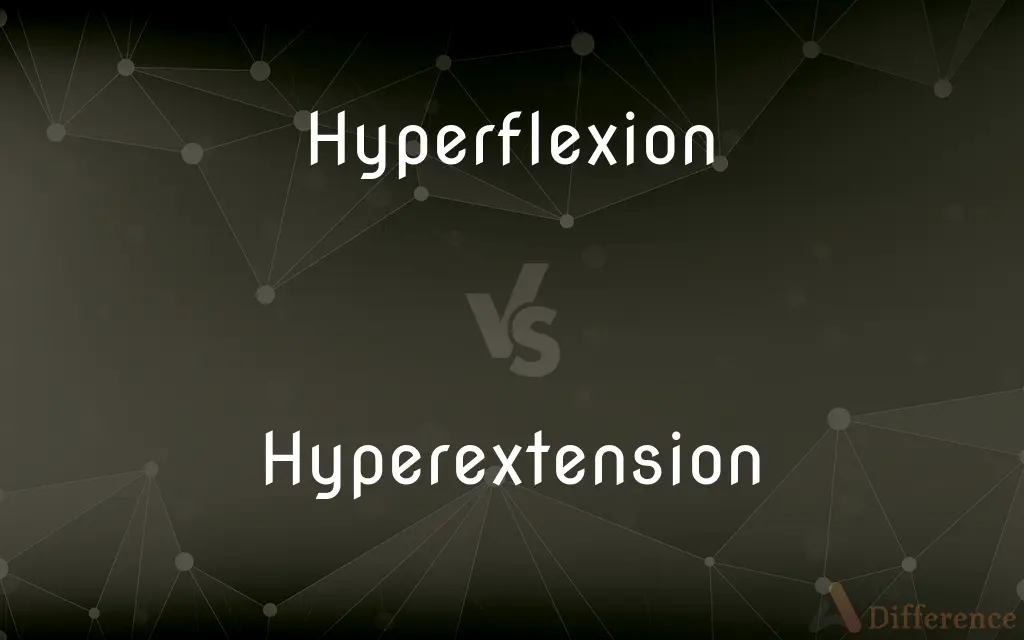Hyperflexion vs. Hyperextension — What's the Difference?
By Fiza Rafique & Urooj Arif — Updated on March 30, 2024
Hyperflexion refers to the excessive bending of a joint, while hyperextension is the excessive straightening beyond its normal range.

Difference Between Hyperflexion and Hyperextension
Table of Contents
ADVERTISEMENT
Key Differences
Hyperflexion involves an extreme bending motion of a joint, pushing it beyond its typical range of motion, which can occur in various parts of the body, such as the neck or fingers. This can lead to strain or injury if the bending is forceful or beyond what the tissues can handle. On the other hand, hyperextension happens when a joint moves beyond its normal range in the opposite direction, extending more than it naturally should. This is common in joints like the elbow or knee and can similarly cause pain or injury if the extension is excessive or abrupt.
The risks associated with hyperflexion often include sprains, strains, or even more severe injuries like ligament tears, depending on the force and the vulnerability of the joint involved. In contrast, hyperextension can lead to similar injuries, with the added risk of damaging the posterior aspects of the joint, such as the ligaments and muscles that support the extension movement. Both movements, when excessive, stress the joint's structures beyond their normal capacity.
Activities or situations leading to hyperflexion might include falling in a way that forces a joint to bend excessively, or during athletic activities where flexibility demands might push the joints beyond their comfortable limits. Hyperextension, conversely, often occurs in sports that involve throwing or overhead motions, such as volleyball or baseball, or in situations where an individual falls and forces a joint to extend excessively to break the fall.
Preventing injuries from hyperflexion and hyperextension involves strengthening the muscles around the joints, increasing flexibility within normal ranges, and using proper techniques during physical activities. Protective gear might also be used in certain sports to limit the range of motion to within safe limits. While hyperflexion focuses on protecting the anterior part of the joint, prevention of hyperextension focuses on the posterior structures.
The treatment for injuries resulting from hyperflexion or hyperextension may involve rest, ice, compression, and elevation (RICE), along with physical therapy to restore strength and flexibility. In severe cases, surgical intervention might be necessary. The focus of rehabilitation often depends on the specific structures injured and the type of excessive movement that caused the injury.
ADVERTISEMENT
Comparison Chart
Definition
Excessive bending of a joint beyond its normal range
Excessive straightening of a joint beyond its normal range
Common Joints
Neck, fingers
Elbow, knee
Potential Injuries
Sprains, ligament tears
Ligament damage, muscle strains
Risk Activities
Falls, excessive bending tasks
Throwing sports, falling backwards
Prevention Focus
Strengthening anterior support structures, improving flexibility
Strengthening posterior support structures, improving flexibility
Compare with Definitions
Hyperflexion
Ligament Stress.
The athlete's hyperflexion injury resulted from pushing his flexibility too far.
Hyperextension
Excessive Straightening.
The hyperextension of his elbow during the game sidelined him for weeks.
Hyperflexion
Joint Strain.
Hyperflexion can lead to joint strains if not careful during exercise.
Hyperextension
Ligament and Muscle Damage.
Falling backwards can cause hyperextension of the wrist, leading to severe pain.
Hyperflexion
Excessive Bending.
Suffering a hyperflexion injury in her wrist, she wore a brace to aid healing.
Hyperextension
Preventive Measures.
Using knee braces can help athletes prevent hyperextension injuries.
Hyperflexion
Beyond Normal Range.
Hyperflexion of the neck during the accident caused severe strain.
Hyperextension
Posterior Joint Stress.
Proper warm-up can reduce the risk of hyperextension injuries in sports.
Hyperflexion
Injury Potential.
To avoid hyperflexion injuries, gymnasts train extensively to strengthen their joints.
Hyperextension
Beyond Normal Range.
Hyperextension injuries in the knee are common in dancers and athletes.
Hyperflexion
Excessive flexion of a joint.
Hyperextension
Extension of a bodily joint beyond its normal range of motion.
Hyperextension
The extension of a joint beyond its normal range; the condition of being hyperextended.
Hyperextension
An exercise performed by lying on the stomach, ideally inclined upwards as on a Roman chair to reach a higher range of motion, and raising and lowering the upper torso.
Hyperextension
Greater than normal extension
Common Curiosities
Can hyperflexion and hyperextension affect the same joint?
Yes, both hyperflexion and hyperextension can affect the same joint, depending on the direction of the force applied.
What are common injuries from hyperflexion?
Common injuries include sprains, ligament tears, and strains.
Can hyperflexion occur without causing injury?
Yes, but repeatedly pushing a joint into hyperflexion increases the risk of injury over time.
What does hyperextension mean?
Hyperextension refers to the excessive straightening of a joint beyond its normal limit, potentially causing damage.
Is treatment for hyperflexion and hyperextension injuries the same?
Treatment often starts similarly with RICE and physical therapy, but specific interventions may vary based on the injury's severity and location.
What injuries are associated with hyperextension?
Injuries can include ligament damage, muscle strains, and joint pain.
What is hyperflexion?
Hyperflexion is the excessive bending of a joint beyond its usual range of motion, which can lead to injury.
How can one prevent hyperflexion injuries?
Prevention includes strengthening muscles, improving flexibility, and using correct techniques in activities.
What are preventive measures against hyperextension?
Measures include strengthening supporting muscles, proper warm-ups, and using protective gear during high-risk activities.
Are athletes more prone to these injuries?
Yes, athletes, particularly in sports requiring extensive flexibility or forceful movements, are at higher risk.
How does one recover from a hyperextension injury?
Recovery typically involves rest, possibly immobilization, followed by physical therapy to regain strength and flexibility.
Can wearing braces prevent hyperextension?
Yes, braces can limit the range of motion to within safe limits, helping prevent hyperextension.
Do hyperflexion and hyperextension always cause long-term damage?
Not always, but without proper treatment and rehabilitation, they can lead to chronic issues.
How does posture affect the risk of hyperflexion and hyperextension?
Poor posture can increase stress on joints, elevating the risk of both hyperflexion and hyperextension injuries.
Can everyday activities lead to hyperflexion or hyperextension?
Yes, activities involving poor ergonomics or repetitive movements can lead to these injuries over time.
Share Your Discovery

Previous Comparison
Empirical vs. Practical
Next Comparison
Obsolete vs. OldAuthor Spotlight
Written by
Fiza RafiqueFiza Rafique is a skilled content writer at AskDifference.com, where she meticulously refines and enhances written pieces. Drawing from her vast editorial expertise, Fiza ensures clarity, accuracy, and precision in every article. Passionate about language, she continually seeks to elevate the quality of content for readers worldwide.
Co-written by
Urooj ArifUrooj is a skilled content writer at Ask Difference, known for her exceptional ability to simplify complex topics into engaging and informative content. With a passion for research and a flair for clear, concise writing, she consistently delivers articles that resonate with our diverse audience.














































